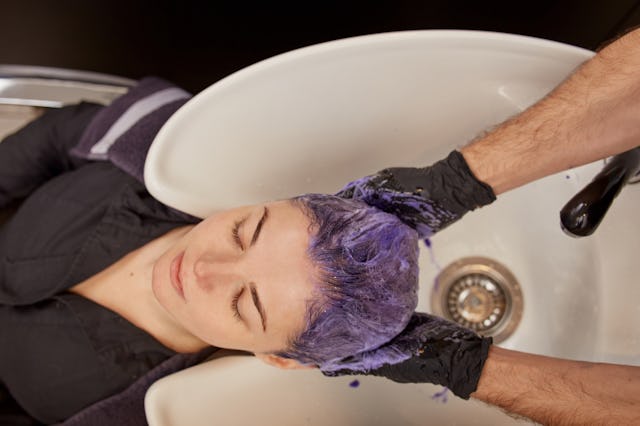Why Are All Gray Hair Shampoos Purple? Inquiring Minds (& Hairs) Need To Know
What does “brassy” even mean? And why can’t going gray mean less work, not more? And is all this stuff just made up to sell us things we don’t need?

If you’re a person of a certain age — 30ish or 40ish, or, if you’re especially ahead of the game, in your mid-to-late 20s — you’ve likely noticed a few wily white hairs corkscrewing skyward from your part, or frosting the area above your ear, or steadily amassing into a streak at your temple. If you’ve proceeded further than that to, say, a full-on silver fox explosion, you may have tried a shampoo or two designed especially for gray hair. Which means you’ve likely noticed something unusual: These products are as purple as pansies, as plums, as the forgotten CSA eggplant rotting in your crisper.
Recently, I found myself wondering why. So, I decided to do a bit of digging, which only increased the gray-haired questions. If you, too, have been wondering about this stuff, join me.
So, what’s the deal with all the purple-hued shampoos?
Gray (and bleached blonde, for that matter) hair can sometimes take on a rusty hue — or, in the parlance of the hair world, it can “turn brassy.” (As in, your hair turns the color of brass. Duh.) Why does this happen? The biggest reason is the sun, the UV rays of which have a tendency to strip the bluer tones in gray hair, heightening the orange ones. Other factors include heat styling tools, medications, salt, chlorine, and pollutants in the air, but whatever the cause, the purple solution is based on the color wheel. What’s the opposite hue of brassy yellow? Purplish blue. Ergo, the thinking goes, if you dump stuff of this color onto your hair, you’ll counteract any gingering.
What’s the ingredient that makes them purple?
Haircare brand Nexxus offers the euphemism “crushed violet pigments.” Other sites just call it “purple pigment.” Custom haircare brand Formulate goes a layer deeper, explaining that purple shampoos use Ext Violet #2, which the Environmental Working Group (EWG) characterizes as a “synthetic colorant.” In other words, without a chemistry degree, you may never know exactly what the ingredient is — but what is known is that it’s found in purple shampoos made by Tresemme, L’Oréal, Bumble and Bumble, and many others.
Does this purple-eradicates-brass theory make sense, and do the shampoos really work?
They seem to help, at least according to shampoo reviews. “Completely got rid of the brass in one use,” said one reviewer. Another touted “amazing results.” But at least a few sites caution that the overuse of purple shampoo can cause dryness and buildup (and even a little purple streaking, eek), and that not all brands are equally effective. It’s also important to bear in mind that purple shampoos can’t work miracles, so manage your expectations. In other words, do your homework before you buy.
I thought letting my hair go gray would make life easier. I have to care about brassiness now?
Well, you don’t have to care about anything. But if your grays start to yellow and it bugs you for some reason, know that the purple stuff is an option.
But don’t people sometimes dye their hair to have “warm caramel tones” or whatever? How is brassiness any different?
Yes, right, thank you — the concept of brassiness does seem a touch farcical, doesn’t it? And super subjective? Like, if your gray hair is more golden than strictly ash-white or silver, and you’re happy with it, why is that a problem? For example, there are some supposedly “warm toned” dye jobs, and some supposedly brassy gray hair, and honestly, we’re struggling to tell the difference and wondering if we’ve been collectively gaslit. (There’s also the debate over whether brassiness is a bad thing.) But, you know, to each their own.
Anything else I need to know, gray hair-wise?
Yes, and this one is most important: Gray hair, brassy or otherwise, is foxy. Cover it up or leave it be; let it turn a little yellow or morph into the color of a prison jumpsuit; use shampoo that’s purple or chartreuse or puce. Whatever you do, know that your aging follicles have put you on the fast track to mature-hot, the kind of sex appeal only we grown-ups get to have. Go forth in grayness — and brassiness if you so desire. In fact, you want to know the other meaning of “brassy”? According to Merriam-Webster, it’s “shamelessly bold.” Sounds pretty good to us.
This article was originally published on